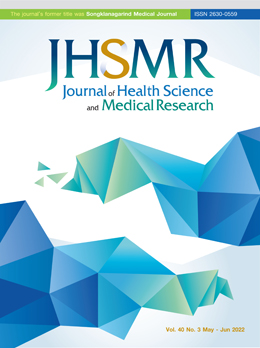Prevalence and Significance of FDG-avid Mediastinal Lymph Nodes in Patients with Colorectal Cancer in a Tuberculosis-endemic Area
DOI:
https://doi.org/10.31584/jhsmr.2021833Keywords:
colorectal cancer, F-18 FDG PET/CT, mediastinal lymph node, tuberculosis-endemic areaAbstract
Objective: To find prevalence and causes of fluorodeoxyglucose (FDG)-avid mediastinal lymph nodes in patients with colorectal cancer in a tuberculosis-endemic area.
Material and Methods: For this study we enrolled patients with colorectal cancer who underwent Fluorine-18 fluorodeoxyglucose positron emission tomography/computed tomography (F-18 FDG PET/CT). Then, PET/CT images were reviewed by a nuclear medicine physician to find mediastinal lymph nodes with FDG uptake beyond the lung background defined as FDG-avid node. The degree of FDG uptake was graded and measured, and associated factors for presence of FDG-avid nodes were evaluated. The causes of FDG-avid nodes were also determined.
Results: A total of 109 patients (64 males; mean age 61.2 years) were studied. Seventy-five patients had FDG-avid mediastinal nodes; accounting for a prevalence of 68.8% (95% CI: 59.2-77.3%). Most of the patients had multiple and bilateral nodes; with the zones of hilar and interlobar being the most common location. Age ≥50 years was the only associated factor for FDG-avid nodes (OR of 3.16, p-value=0.035). Only one out of the 32 patients (with fulfilled followup criteria) had a metastatic node.
Conclusion: The prevalence of FDG-avid mediastinal nodes in colorectal cancer patients in a tuberculosis-endemic area was significantly high. Most of the lesions were benign in nature; thus, interpretation of these findings should be considered carefully to avoid false-positive results.
References
Bray F, Ferlay J, Soerjomataram I, Siegel RL, Torre LA, Jemal A. Global cancer statistics 2018: GLOBOCAN estimates of incidence and mortality worldwide for 36 cancers in 185 countries. CA Cancer J Clin 2018;68:394–424.
Dekker E, Tanis PJ, Vleugels JLA, Kasi PM, Wallace MB. Colorectal cancer. Lancet 2019;394:1467–80.
Riihim ki M, Hemminki A, Sundquist J, Hemminki K. Patterns of metastasis in colon and rectal cancer. Sci Rep 2016;6: 29765.
Libson E, Bloom RA, Halperin I, Peretz T, Husband JE. Mediastinal lymph node metastases from gastrointestinal carcinoma. Cancer 1987;59:1490–3.
Toda K, Kawada K, Sakai Y, Izumi H. Metachronous mediastinal lymph node metastasis from ascending colon cancer: A case report and literature review. Int J Surg Case Rep 2017;41: 336–9.
Iwata T, Chung K, Hanada S, Toda M, Nakata K, Kato T, et al. Solitary bulky mediastinal lymph node metastasis from colon cancer. Ann Thorac Cardiovasc Surg 2013;19:313–5.
Kuba H, Sato N, Uchiyama A, Nakafusa Y, Mibu R, Yoshida K, et al. Mediastinal lymph node metastasis of colon cancer: eport of a case. Surg Today 1999;29:375–7.
Matsuda Y, Yano M, Miyoshi N, Noura S, Ohue M, Sugimura K, et al. Solitary mediastinal lymph node recurrence after curative resection of colon cancer. World J Gastrointest Surg 2014;6:164–8.
Jadvar H, Colletti PM, Delgado-Bolton R, Esposito G, Krause BJ, Iagaru AH, et al. Appropriate Use Criteria for 18F-FDG PET/CT in Restaging and Treatment Response Assessment of Malignant Disease. J Nucl Med 2017;58:2026-37.
Yen RF, Chen KC, Lee JM, Chang YC, Wang J, Cheng MF, et al. 18F-FDG PET for the lymph node staging of nonsmall cell lung cancer in a tuberculosis-endemic country: is dual time point imaging worth the effort? Eur J Nucl Med Mol Imaging 2008;35:1305–15.
Lee SH, Min JW, Lee CH, Park CM, Goo JM, Chung DH, et al. Impact of parenchymal tuberculosis sequelae on mediastinal lymph node staging in patients with lung cancer. J Korean Med Sci 2011;26:67–70.
Chuchottaworn C, Thanachartwet V, Sangsayunh P, Than TZM, Sahassananda D, Surabotsophon M, et al. Risk Factors for Multidrug- Resistant Tuberculosis among Patients with Pulmonary Tuberculosis at the Central Chest Institute of Thailand. PLoS ONE 2015;10:e0139986.
Global Tuberculosis Report 2020 [monograph on Internet]. Geneva: World Health Organization; 2020 [cited 2021 Jan 16]. Available from: https://www.who.int/publications/i/item/ 9789240013131
Abrar M, Bhoil A, Kashyap R, Bhattacharya A, Mittal B. Incidence and significance of FDG uptake in mediastinal lymph nodes in patients undergoing FDG PET/CT for abdomino-pelvic malignancies - An Indian perspective. J Nucl Med 2012;53: 1448.
Kumar A, Dutta R, Kannan U, Kumar R, Khilnani GC, Gupta SD. Evaluation of mediastinal lymph nodes using 18F-FDG PET-CT scan and its histopathologic correlation. Ann Thorac Med 2011;6:11–6.
Kwan A, Seltzer M, Czernin J, Chou MJ, Kao CH. Characterization of hilar lymph node by 18F-fluoro-2-deoxyglucose positron emission tomography in healthy subjects. Anticancer Res 2001;21:701–6.
Kang WJ, Chung J-K, So Y, Jeong JM, Lee DS, Lee MC. Differentiation of mediastinal FDG uptake observed in patients with non-thoracic tumours. Eur J Nucl Med Mol Imaging 2004; 31:202–7.
Konishi J, Yamazaki K, Tsukamoto E, Tamaki N, Onodera Y, Otake T, et al. Mediastinal lymph node staging by FDG-PET in patients with non-small cell lung cancer: analysis of falsepositive FDG-PET findings. Respiration 2003;70:500–6.
Paton NI, Borand L, Benedicto J, Kyi MM, Mahmud AM, Norazmi MN, et al. Diagnosis and management of latent tuberculosis infection in Asia: Review of current status and challenges Int J Infect Dis 2019;87:21–9.
Karam M, Roberts-Klein S, Shet N, Chang J, Feustel P. Bilateral hilar foci on 18F-FDG PET scan in patients without lung cancer: variables associated with benign and malignant etiology. J Nucl Med 2008;49:1429–36.
Downloads
Published
How to Cite
Issue
Section
License

This work is licensed under a Creative Commons Attribution-NonCommercial-NoDerivatives 4.0 International License.
























